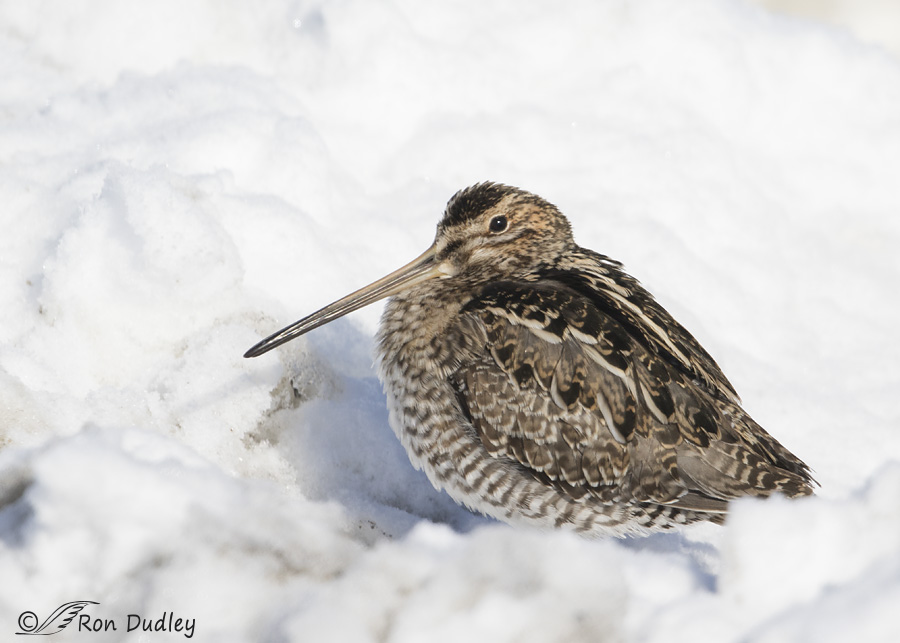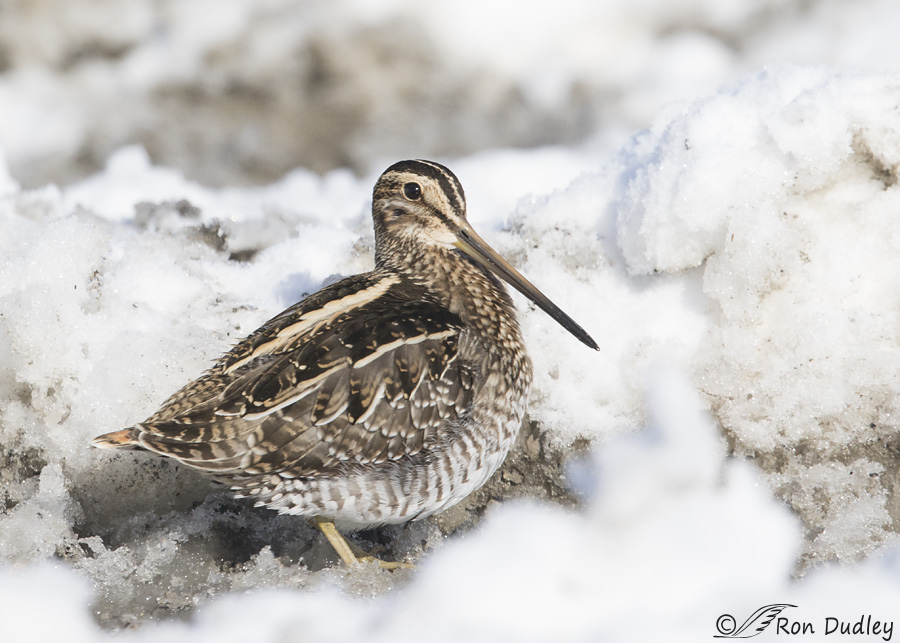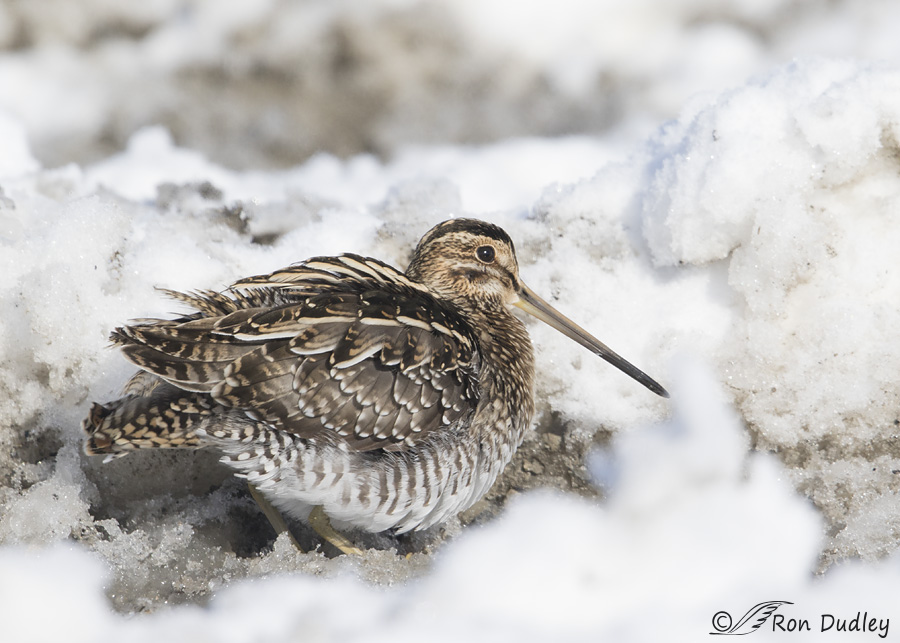These two snipes almost flew in my pickup window.

1/2000, f/7.1, ISO 320, Canon 7D Mark II, Canon EF 500mm f/4L IS II USM + EF 1.4 III Extender, not baited, set up or called in
Four days ago I was driving across a snowy parking lot at Farmington Bay when two Wilson’s Snipes appeared out of nowhere and flew within a couple of feet of my open windows. They then circled around and landed in some vehicle tire tracks in the snow. These are elusive birds and I’m sure they chose to land in the tracks rather than anywhere else in the undisturbed snow for the cover those tracks provided. They thought they were well-hidden in the tracks so I was able to approach them closely.
The eyes of these strange birds are one of their more unusual features. They’re set remarkably far back on their heads which provides them full vision on both sides and binocular overlap to the rear. This allows them to detect the approach of a predator from behind while their beak is deeply buried in the mud or sand.

1/1600, f/7.1, ISO 320, Canon 7D Mark II, Canon EF 500mm f/4L IS II USM + EF 1.4 III Extender, not baited, set up or called in
The second bird had landed nearby in a dirtier track in the snow but I had a more exposed look at it. These birds are typically so elusive that they’re usually not even seen until they’re flushed at short range so it was fun getting a close detailed look at them even though they barely moved while I had my lens on them.

1/1600, f/7.1, ISO 320, Canon 7D Mark II, Canon EF 500mm f/4L IS II USM + EF 1.4 III Extender, not baited, set up or called in
This one gave me a short rouse (feather fluff) but that was about it in the posing department. Shortly after I drove away and left them in place.
Even though the summer range of Wilson’s Snipes extends down (barely) into northern Utah I rarely see them anytime except during winter. I suspect that may be because when the marshes are frozen and snow-covered they spend more time feeding near where water is still running in the liquid form so some of the mud remains unfrozen.
And those are the types of places I often haunt during the winter.
Ron


Hi Ron, I am hoping you will let me use a few of your photos to paint images. Specifically , at this time, your photo of the two burrowing owls stabbing close together with one owl’s head tilted.
Great photography!
Thanks for your interest, Georgina but I require a modest licensing fee for such use.
Great photos!
They’ve got wonderful plumage!
Marvelous find and shots Ron! Happy New Year!
Carlotte
Miracles of nature and of adaptation. And resilience. And beautiful with it.
Good luck with your painting.
I finished it, WC. Looks good if I do say so myself. The old color looked pretty crappy with the new siding.
What gorgeous birds (she said redundantly again)! I don’t think I’ve ever seen them in The Great Out There–just photos.
That line-of-sight thing is pretty ingenious. Rabbits have that ability, too. Adaptation is a good thing
“Rabbits have that ability, too”
Which I suspect makes them pretty challenging prey for falconer’s birds…
Yes, indeed Ron. Rabbits (including jackrabbits) have some amazing escape strategies. The ones that survive to make more bunnies have perfected the ability to wait until the hawk commits and THEN jink out of the way. It goes to the idea that panic is a bad decision from which a whole bunch of other bad decisions flow. If they have the fortitude to hold until the last second, they’re gone, making the hawk crash to the ground with empty talons. Jackrabbits can make huge jumps and often fight their way out of being caught, unless the hawk learns that both the head and the back legs must be under control. If not, a strenuous rodeo competition ensues and the hawk might not win that battle.
Nature’s adaptations are so fascinating!
Beautiful bird and sun too.
Beautiful shots of an elusive bird, Ron. I’m also enjoying the sparkly light play off some of the snow. For some reason, I feel like the tire tracks really add to the overall composition of these photographs. Weird, huh?
I like the snow too, Marty. I just wish there wasn’t so much mud in the snow for that one bird.
Beautiful birds…they have such a variety of feather patterns, all beautiful….woukd be a woodcarver’s nightmare, right Dick?
A challenge rather then a nightmare Patty. If a carver is going to take on carving this bird he/she has already committed to dealing with the painting and the vermiculation. If he/she is just going to carve the bird with little to no feathering or vermiculation then the problem is mute. If I was younger ………
Sure glad all I have to do is take the photos. Carving and painting aren’t my cup of java (though I’m putting the second paint coat on my garage door this morning…)
With or without vermiculation?
With. Unintentional mistakes, but they’re there…
Ha Ha Ha Ha………
Do their feathers “whistle” like the Common Snipe? For years I tried to figure out what bird made that noise and was so surprised to see what caused it. Beautiful markings.
I don’t recall hearing them whistle, Jane. I believe a woodcock’s feathers whistle…
Well hidden, huh? I’m glad they didn’t know how visible they were to your camera, because that’s certainly the only way I’ll likely see them. The info about their vision is very interesting. And their feather patterns are gorgeous.
I agree about their feather patterns, Susan. They remind me just a little of those on meadowlarks, which I’ve always admired.
First of them I’ve ever seen – neat bird and good detailed shots of them! You probably would have appreciated the “binocular overlap to the rear” when you were teaching also!
Good point about my teaching days. There were a few times where it would have been very helpful. That said, my kids didn’t get the best of me often. I remembered all the tricks and shenanigans from when I was a student!
Ain’t it the truth! As long as the kids *think* we have eyes in the backs of our heads, we’re good.
Great shots Ron!
There is a ton of vermiculation on this bird – there is significant challenge to painting that vermiculation accurately whether on canvas of on a carving.
Wonderful close shots Ron, many thanks for sharing.
I like how you always notice vermiculation, Dick – the eye of a woodcarver!
“Binocular overlap to the rear”. Interesting. Thanks for the tidbit of info and nice shots, once again.
I wish we could do that, Frank. I sure would spot more birds that way!
Wouldn’t it be cool to have 360 vision. Think it might be a little confusing however. The concept of “front” might get a little hard to distinguish.
I’d have to have much smaller ears for it to work well for me…:)
Funny! If humans had this characteristic, perhaps the ear location might have moved to to help with the 360 degree potential. Which way, up or down?
I’d rather have my ears on top of my head (like many other mammals do) than under my chin…